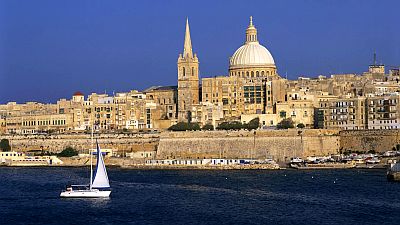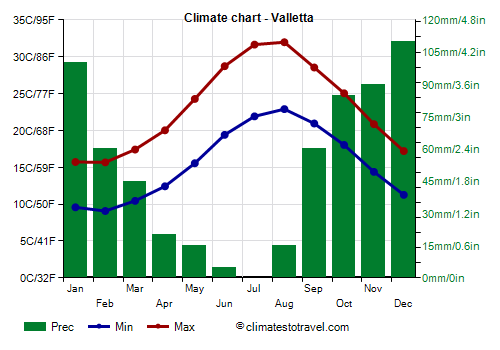Select units of measurement for the temperature and rainfall tables (metric or imperial).
Average weather, temperature, rainfall, sunshine
In Malta, there is a
Mediterranean climate, with mild, rainy winters and hot, sunny summers.
The
rains are concentrated in the period September-March, with a maximum from October to January. In the other months, the rains are scarce, and in summer it almost never rains.
Malta is an archipelago located in the center of the Mediterranean Sea, consisting of three main islands, Malta (Malta), Gozo (Ghawdex) and Comino (Kemmuna), as well as some uninhabited islands.
The climate in detail
The seasons
Winter, from December to February, is mild, and the daily temperature range is limited.
In this season, sunny periods alternate with
periods of bad weather, with rain and wind.
Cold days are rare: at most, there may be some days with highs of 9/10 °C (48/50 °F). On the coldest nights of the year, the temperature typically drops to 4/5 °C (39/41 °F).
The temperature almost never drops below freezing: at the airport, it dropped to 1/2 °C (34/36 °F) in the coldest winters, although in the center of the island, it dropped to -1.5 °C (29 °F) in 1962.
Snow in Malta is extremely rare. The last snowfall occurred in January 1962. However, in December 2014, a light snowfall was observed in some areas, especially in Dingli, in the highest part of the island, at 235 meters (770 feet).
In
spring, the temperature gradually rises. The rains become less and less frequent, and as early as in April, they begin to be rare. The sun shines more and more unchallenged.
Sometimes, the Maltese archipelago can be affected by the
Sirocco, a hot, dry wind blowing from the Saharan desert, often accompanied by dust or sand. This wind blows more frequently in spring and autumn, and is able to raise the temperature by several degrees.
 Summer
Summer, from June to August, is hot and sunny.
Even if the breezes blow, the
humidity often makes the heat uncomfortable.
Furthermore, the wind from Africa can bring
very hot periods, in which the temperature can reach or exceed 40 °C (104 °F). For example, the temperature reached 42.5 °C (108.5 °F) in July 1988 and in July 1998, 44 °C (111 °F) in August 1999, 41.5 °C (106.5 °F) in July 2009, and 41 °C (106 °F) in August 2012.
In
autumn, the temperature is initially high, and then gradually decreases. In September, there's still summer-like weather, especially in the first half; usually, the first disturbances arrive at the end of the month, accompanied by thunderstorms. In October, the temperature is still pleasant, with highs around 25 °C (77 °F).
Valletta

In the capital, Valletta, the average
temperature ranges from 12.5 °C (54.5 °F) in February to 27.5 °C (81.5 °F) in August.
Rainfall is not abundant, in fact, it amounts to 600 millimeters (23.5 inches) per year, however, from October to January it is equal to or higher than 85 mm (3.3 in) per month.
The amount of
sunshine in Malta is great in summer, when clear skies prevail. In winter, there are a good number of sunny periods, but they alternate with periods of bad weather, with rain, wind and thunderstorms.
However, with 3,000 hours of sunshine per year, Malta is one of the sunniest places in Europe.
Sea temperature
The
sea in Malta is warm enough to swim in from July to October, while it's still a bit cool in June, about 22 °C (72 °F). H
When to go
The islands of the archipelago, with their characteristic towns, villages and ports, can be preferably explored in
April, May and the first half of October, since it can get very hot in summer.
For a
beach holiday, instead, the summer, from June to September, is the best season.
What to pack
In
winter: bring spring/autumn clothes, a sweater, a jacket, and a raincoat or umbrella.
In
summer: bring light clothing, sunscreen, a sun hat, a light sweatshirt for the evening, and a light scarf for the breeze.
Climate data - Malta
| Valletta |
|---|
|
| Jan | Feb | Mar | Apr | May | Jun | Jul | Aug | Sep | Oct | Nov | Dec |
|---|
| Min temp. | 10 | 9 | 10 | 12 | 16 | 19 | 22 | 23 | 21 | 18 | 14 | 11 |
|---|
| Max temp. | 16 | 16 | 17 | 20 | 24 | 29 | 32 | 32 | 29 | 25 | 21 | 17 |
|---|
| Precip. | 100 | 60 | 45 | 20 | 15 | 5 | 0 | 15 | 60 | 85 | 90 | 110 |
|---|
| Prec. days | 10 | 7 | 5 | 4 | 1 | 1 | 0 | 1 | 4 | 6 | 9 | 10 |
|---|
| Humidity | 77% | 76% | 76% | 74% | 69% | 64% | 63% | 66% | 72% | 76% | 75% | 75% |
|---|
| Day length | 10 | 11 | 12 | 13 | 14 | 15 | 14 | 13 | 12 | 11 | 10 | 10 |
|---|
| Sun hours | 5 | 6 | 7 | 8 | 10 | 11 | 12 | 11 | 9 | 7 | 6 | 5 |
|---|
| Sea temp | 17 | 16 | 16 | 16 | 19 | 22 | 25 | 27 | 26 | 24 | 21 | 18 |
|---|